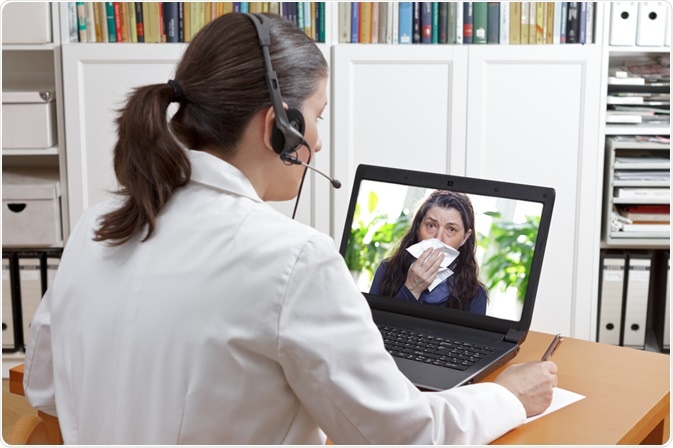There are three main types of telemedicine, which include store-and-forward, remote monitoring, and real-time interactive services. Each of these has a beneficial role to play in overall health care and, when utilized properly, can offer tangible benefits for both healthcare workers and patients.

Image Credit: Agenturfotografin / Shutterstock.com
Store-and-forward
Store-and-forward telemedicine surpasses the need for the medical practitioner to meet in person with a patient. Instead, patient information such as medical images or biosignals can be sent to the specialist as needed when it has been acquired from the patient. This practice is common in the medical fields of dermatology, radiology, and pathology.
With proper structure and care, store-and-forward telemedicine can save time and allow medical practitioners to serve the public with their services more fully. However, this form of telemedicine relies on a history report and documented information or images, rather than a physical examination, which has the potential to cause complications such as misdiagnosis.
Remote monitoring
Also known as self-monitoring or self-testing, remote monitoring uses a range of technological devices to monitor the health and clinical signs of a patient remotely. This is extensively used in the management of chronic diseases such as cardiovascular disease, diabetes mellitus, and asthma.
Some of the benefits associated with remote monitoring include cost-effectiveness, more frequent monitoring, and greater patient satisfaction. There is some risk that tests conducted by the patients themselves may be inaccurate; however, the outcomes are generally thought to be similar to professional-patient tests.
Real-time interactive services
Interactive services can provide immediate advice to patients who require medical attention. There are several different mediums utilized for this purpose, including phone, online, and home visits. A medical history and consultation about presenting symptoms can be undertaken, followed by an assessment similar to that which is usually conducted during face-to-face appointments.
Teleneuropsychology
Teleneuropsychology is an example of this type of telemedicine that includes neuropsychological consultation and assessment over the phone with patients who have or are suspected to have a cognitive disorder. Standard evaluation techniques are implemented to assess the patient via video technology. A study from 2014 found that this form of telemedicine provides a feasible and reliable alternative to traditional in-person consultations, although it was noted that quality standards and administration must be upheld.
Telenursing
Telenursing refers to the utilization of communicative technologies to provide remote nursing services. Consultations can be made over the phone to reach a diagnosis and monitor health conditions and symptoms.
This form of telemedicine is growing in favor due to the low cost and high accessibility of the services to patients, particularly for those in rural regions. It also has the potential to lessen the burden of patients in hospitals because it is possible to address minor ailments earlier and patients can receive advice about whether hospital admission is required.
Telepharmacy
Telepharmacy provides pharmaceutical advice to patients when direct contact with a pharmacist is not possible. This allows medications to be monitored and patients can be offered advice over the phone.
Depending on regulations, refill authorization may be given to allow patients to receive regular medications when required.
Telerehabilitation
Telerehabilitation utilizes technology to communicate and perform clinical assessment and therapy for rehabilitation patients. This usually has a strong visual element with video conferences and webcams commonly used to assist in communicating symptoms and clinical progress.
Conclusion
Telemedicine services are a great step forward in improving the accessibility of healthcare to all patients, particularly those living in areas with limited local health professionals. Additionally, they offer a significant benefit of reduced cost in comparison to traditional in-person appointments.
References
Further Reading
Last Updated: Mar 11, 2023